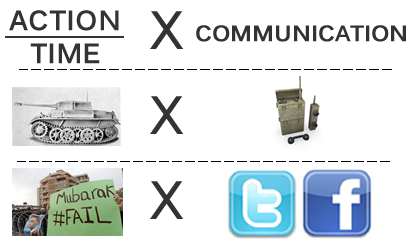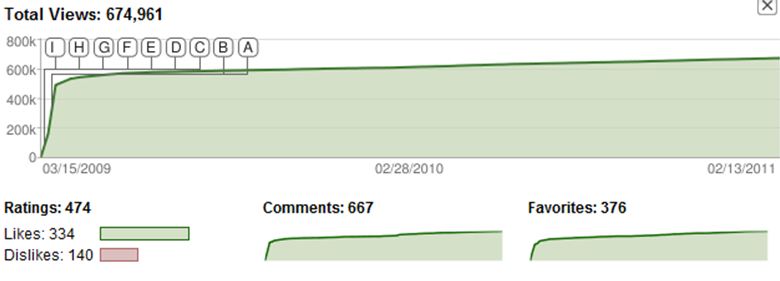On May 10, 1940, Germany launched a blitzkrieg campaign against France. Less than five weeks later the French surrendered when the Maginot Line was outflanked by German Panzer tanks. The blitzkrieg, or lightning war tactics, relied on a fast moving tank army networked together with radios that provided real time communication with infantry. If this strategy were boiled down to an equation it would look something like this:
([Action]/[Time]) x [Communication] 
Flash forward to Egypt -- Jan 25, 2011, the people of Egypt are ignited by the uprising in Tunisia and organize to take action in Tahrir square to remove Mubarak from power. Internet organizer and activist Wael Ghonim created a Facebook fanpage "We are all Khaled Said" to honor an activist that was killed by police and uses it to help organize the Jan 25 "Day of Rage" -- the largest protest in recent Egyptian history (Good Wael Ghonim Article). Wael and other protestors are able to communicate real time in the streets using the Twitter hashtag #Egypt and are only incensed further when the government cuts the internet and kidnaps Wael. Barely two weeks later, on February 10, President Mubarak steps down from power in response to overwhelming pressure from the Egyptian people (full timeline of events).
The Egyptian people took intense action over a short amount of time and communicated real time via Twitter, mobile phones and Facebook while protesting. The German blitzkrieg used intense action over a short time, using a radio network in tanks to overwhelm the French military. The results in both cases led to the toppling of a government within weeks.
Three Reasons to Go Hard Early
- Promoting YouTube Videos The most important time for a YouTube video is the first 48 hours after posting. The YouTube algorithm identifies the most popular new videos and chooses those videos to surface in search results and to be featured in category pages. This means if you are launching a new video the best strategy to maximize its number of views is to coordinate your network to promote it early. Your goal is to drive "thumbs up," comments and video ratings as soon as the video is launched. If you can achieve approximately 30,000 views in the first two days you will likely end up featured on the front page of YouTube -- generating thousands of organic views. Even if 30,000 is not achieved in, there is still a snowball effect of generating early buzz because YouTube will feature the video in other categories on the site.
 (stats from DoSomething.org's 1 in 3 dating abuse campaign video that went viral, notice the early spike of attention instead of a slow steady climb)
(stats from DoSomething.org's 1 in 3 dating abuse campaign video that went viral, notice the early spike of attention instead of a slow steady climb) Like YouTube, popular crowd fundraising sites have developed algorithms that benefit projects that have gained early attention. Indiegogo, a crowd fundraising (indiegogo.com) site that allows you to raise money for your project or idea, and DonorsChoose.org, which allows teachers to fundraiser around their classroom needs, both have systems that reward early intensity.
According to Indiegogo stats, successful campaigns raise an average 20 percent of their funding in the first seven days. Also the majority of successful campaigns choose a 30-60 day goal window (the maximum allowed is 120 days). This early intensity leads to a snowball effect due to the 'gogo factor' which rewards these active campaigns by featuring them on the site (great music project that needs help, list of successful projects).
According to Donor's Choose's data, teachers that get 50 percent of their project funded in the first two weeks have a 20 percent higher success rate. A normal project completion rate is 63 percent, this number jumps to 83 percent when there is early intensity. Again there is an algorithmic snowball effect where projects with early intensity get featured across the site generating organic buzz and funding from outside the teacher's personal network (support a music teacher's classroom).
Variables
A blitzkrieg strategy treats both action and time as variables that can be manipulated. All of the cases mentioned in this article leverage the benefits of strategically increasing action over a decreased amount of time to maximize impact.
Just setting a deadline or mobilizing a crowd is not enough. If Egyptian protesters distributed their action over a six month period the intensity would never have reached the boiling point that drew overwhelming international attention. If the Germans had engaged in trench warfare tactics from WWI, the occupation of France would have taken months if it were successful.
Social media is not the action, it is a communication variable that has the power to amplify -- if used correctly. When action, time and communication are used with a blitzkrieg approach -- greater impact can be achieved regardless of whether you're funding a classroom or overthrowing a government.